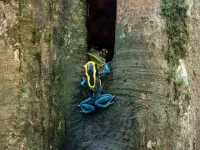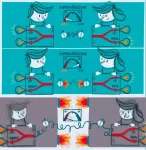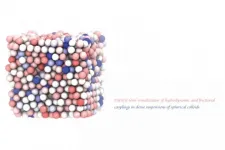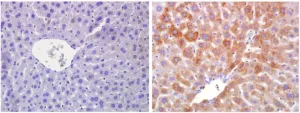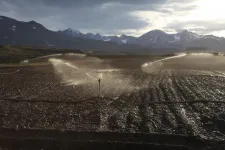(Press-News.org) A group of researchers from the University of Jyvaskyla and Stanford University were part of an expedition to French Guiana to study tropical frogs in the Amazon. Various amphibian species of this region use ephemeral pools of water as their nurseries, and display unique preferences for specific physical and chemical characteristics. Despite species-specific preferences, researchers were surprised to find tadpoles of the dyeing poison frog surviving in an incredible range of both chemical (pH 3-8) and vertical (0-20 m in height) deposition sites. This research was published in the journal Ecology and Evolution in June 2021.
Neotropical frogs are special because, unlike species in temperate regions, many tropical frogs lay their eggs on the ground. This becomes an issue once tadpoles (who breathe using gills, like fish) hatch onto the forest floor, but poison frogs have developed innovative solutions to get their tadpoles to suitable aquatic habitats: piggy-back rides. In many of these terrestrial-breeding species, fathers will transport recently hatched tadpoles from the ground to pools of water formed by vegetation (like fallen trees or bromeliads).
PhD researcher Chloe Fouilloux and team leaders Dr. Bibiana Rojas from University of Jyvaskyla, Finland and Dr. Andrius Pasukonis from Stanford University wanted to know if different species (Dendrobates tinctorius, Allobates femoralis, and Osteocephalus oophagus) considered a combination of biological, physical, or chemical characteristics of pools when choosing nurseries for their young.
To find that out, this group of eight researchers sampled more than 100 pools over two years, which involved searching for suitable deposition sites that ranged from the ground to over 20 meter in vertical height (reached by climbing trees).
Of the three species, range and tolerance of D. tinctorius (dyeing poison frog) tadpoles was beyond what any of the researchers imagined physiologically possible: healthy tadpoles were found in a range of pools with a pH of around 3 to a pH of 8, which represents a 100,000x change of hydrogen ion concentration; in other words, these tadpoles were successfully developing in pools of what is chemically more acidic than orange juice to pools that have similar ionic concentrations to sea water!
The deposition choices of dyeing poison frogs confused researchers in other ways, too: tadpoles of this species are aggressive cannibals, which is why they are usually found to occur in low densities (1-2 tadpoles) per pool.
"However, in this study, we found several instances of more than 10 tadpoles of this species coexisting in the same nursery. The reason why fathers would deposit so many cannibals within the same pool, or if cannibalism occurs within these special pools, has yet to be tested", says PhD researcher Chloe Fouilloux from University of Jyväskylä.
Healthier males transporting their tadpoles to more suitable conditions?
From a parental perspective, dyeing poison frog fathers were found to carry their tadpoles more than 20 meters above the forest floor: for a frog that is about 4 centimeter long, 20 meters is 500 times their body length. In human terms, this physical feat would be equivalent to having a 1.65 meter person climbing up a giant (non-existent, obviously) tree of about 825 meters!
But why do fathers sometimes carry their tadpoles one meter away from where they hatched, and other times transport them to the tops of trees?
When looking at the chemical and biological trends, it appears that more biologically "comfortable" nurseries are found higher in trees. One possible explanation for this finding is that healthier males are able to invest more energy in transporting their tadpoles to more suitable conditions, but this is something that would need to be investigated in the future. Ultimately, there remains a lot to be learnt about the physiology and parental care of these animals; the degree of chemical flexibility found in these tadpoles is extremely unusual, and the secret underlying their resilience remains unknown.
"This work helps highlighting the amazing diversity observed between and among species in the wild: parents from different species prioritise unique characteristics when choosing pools to raise their offspring, which shapes both how species interact with each other and how they specialize in occupying different parts of the environment", states Dr. Bibiana Rojas from University of Jyväskylä.
This variation opens the door to future research that explores how species influence each other and how pool choice by parents affects tadpole development and survival.
INFORMATION:
The research was published in journal Ecology and Evolution in June 15, 2021: https://onlinelibrary.wiley.com/doi/10.1002/ece3.7741
For further information:
Chloe Fouilloux, University of Jyvaskyla, chloe.a.fouilloux@jyu.fi, tel. +358 41 725 7825
Bibiana Rojas, University of Jyvaskyla, bibiana.rojas@jyu.fi, tel. +358 40 805 4622
Andrius Pasukonis, Stanford University, apasukonis@stanford.edu
Communications Specialist Tanja Heikkinen, University of Jyvaskyla, tanja.s.heikkinen@jyu.fi, +358 50 472 1162
https://www.jyu.fi/en
https://www.jyu.fi/science/en
Twitter: @uniofjyvaskyla Facebook: @JyvaskylaUniversity
Postdoctoral Researcher Outi Keinänen from the University of Helsinki developed a method to radiolabel plastic particles in order to observe their biodistribution on the basis of radioactivity with the help of positron emission tomography (PET). As a radiochemist, Keinänen has in her previous radiopharmaceutical studies utilised PET imaging combined with computed tomography (CT), which produces a very accurate image of the anatomical location of the radioactivity signal.
In the recently completed study, radiolabelled plastic particles were fed to mice, and their elimination from the body was followed with PET-CT scans. This was the first time that ...
Research published today in the Journal of General Virology has identified missed cases of SARS-CoV-2 by retrospective testing of throat swabs.
Researchers at the University of Nottingham screened 1,660 routine diagnostic specimens which had been collected at a Nottingham hospital between 2 January and 11 March 2020 and tested for SARS-CoV-2 by PCR. At this stage of the pandemic, there was very little COVID-19 testing available in hospitals, and to qualify patients had to meet a strict criterion, including recent travel to certain countries in Asia or contact with a known positive case.
Three previously unidentified cases of SARS-CoV-2 infection were identified by the retrospective screening, including one from a 75-year-old ...
The phenomenon of quantum nonlocality defies our everyday intuition. It shows the strong correlations between several quantum particles some of which change their state instantaneously when the others are measured, regardless of the distance between them. While this phenomenon has been confirmed for slow moving particles, it has been debated whether nonlocality is preserved when particles move very fast at velocities close to the speed of light, and even more so when those velocities are quantum mechanically indefinite. Now, researchers from the University of Vienna, the Austrian Academy of Sciences and the Perimeter Institute report in the latest issue of Physical Review Letters that ...
Tokyo, Japan - Colloids--mixtures of particles made from one substance, dispersed in another substance--crop up in numerous areas of everyday life, including cosmetics, food and dyes, and form important systems within our bodies. Understanding the behavior of colloids therefore has wide-ranging implications, yet investigating the rotation of spherical particles has been challenging. Now, an international team including researchers from The University of Tokyo Institute of Industrial Science has created particles with an off-center core or "eye" that can be tracked ...
Getting energy and nutrients from the environment - that is, eating - is such an important function that it has been regulated through sophisticated mechanisms over hundreds of millions of years. Some of these mechanisms are only now beginning to be unravelled. A group at the Spanish National Cancer Research Centre (CNIO) has found one of their key components - a switch that controls the ability of organisms to adapt to low cellular nutrient levels.
The protein involved is RagA, which is part of the mTOR molecular pathway, whose importance in metabolic activity regulation has been known for decades now. CNIO researchers have found that if RagA is continuously activated, cells do not know that there are no sufficient nutrients and so ...
The encryption algorithm GEA-1 was implemented in mobile phones in the 1990s to encrypt data connections. Since then, it has been kept secret. Now, a research team from Ruhr-Universität Bochum (RUB), together with colleagues from France and Norway, has analysed the algorithm and has come to the following conclusion: GEA-1 is so easy to break that it must be a deliberately weak encryption that was built in as a backdoor. Although the vulnerability is still present in many modern mobile phones, it no longer poses any significant threat to users, according to the researchers.
Backdoors not useful according to researchers
"Even though intelligence services and ministers of the interior understandably want such backdoors ...
ENVIRONMENT Diesel-polluted soil from now defunct military outposts in Greenland can be remediated using naturally occurring soil bacteria according to an extensive five-year experiment in Mestersvig, East Greenland, to which the University of Copenhagen has contributed.
Mothballed military outposts and stacks of rusting oil drums aren't an unusual sight in Greenland. Indeed, there are about 30 abandoned military installations in Greenland where diesel, once used to keep generators and other machinery running, may have seeped into the ground.
This is the case with Station 9117 Mestersvig, an abandoned military airfield ...
These findings were published in the journal Cellular and Molecular Life Sciences on 8 June 2021.
Huge splicing diversity in the brain
The human genome was sequenced around 20 years ago. Since then, the sequence information encoding our proteins is known - at least in principle. However, this information is not continuously stored in the individual genes, but is divided into smaller coding sections. These coding sections, also known as exons, are assembled in a process called splicing. Depending on the gene, different exon combinations are possible, which is why they are referred to as different or ...
With increasing vaccination rates and decreasing numbers of infections, the population's feeling of safety is also rising. As the results of the 37th edition of the BfR-Corona-Monitor, a regular survey conducted by the German Federal Institute for Risk Assessment (BfR), show, the majority of the population in Germany thinks it can control its risk of an infection well. "62 percent are confident that they can protect themselves from an infection with the coronavirus," says BfR-President Professor Dr. Dr. Andreas Hensel. "We see that the feeling of safety has increased considerably. ...
Chinese researchers have recently discovered links between reduction in microbial stability and soil carbon loss in the active layer of degraded alpine permafrost on the Qinghai-Tibet Plateau (QTP).
The researchers, headed by Prof. CHEN Shengyun from the Northwest Institute of Eco-Environment and Resources (NIEER) of the Chinese Academy of Sciences (CAS), and XUE Kai from University of Chinese Academy of Sciences, conducted a combined in-depth analysis of soil microbial communities and their co-occurrence networks in the active permafrost layer along an extensive gradient of permafrost degradation.
The QTP encompasses the largest extent of high-altitude mountain ...
